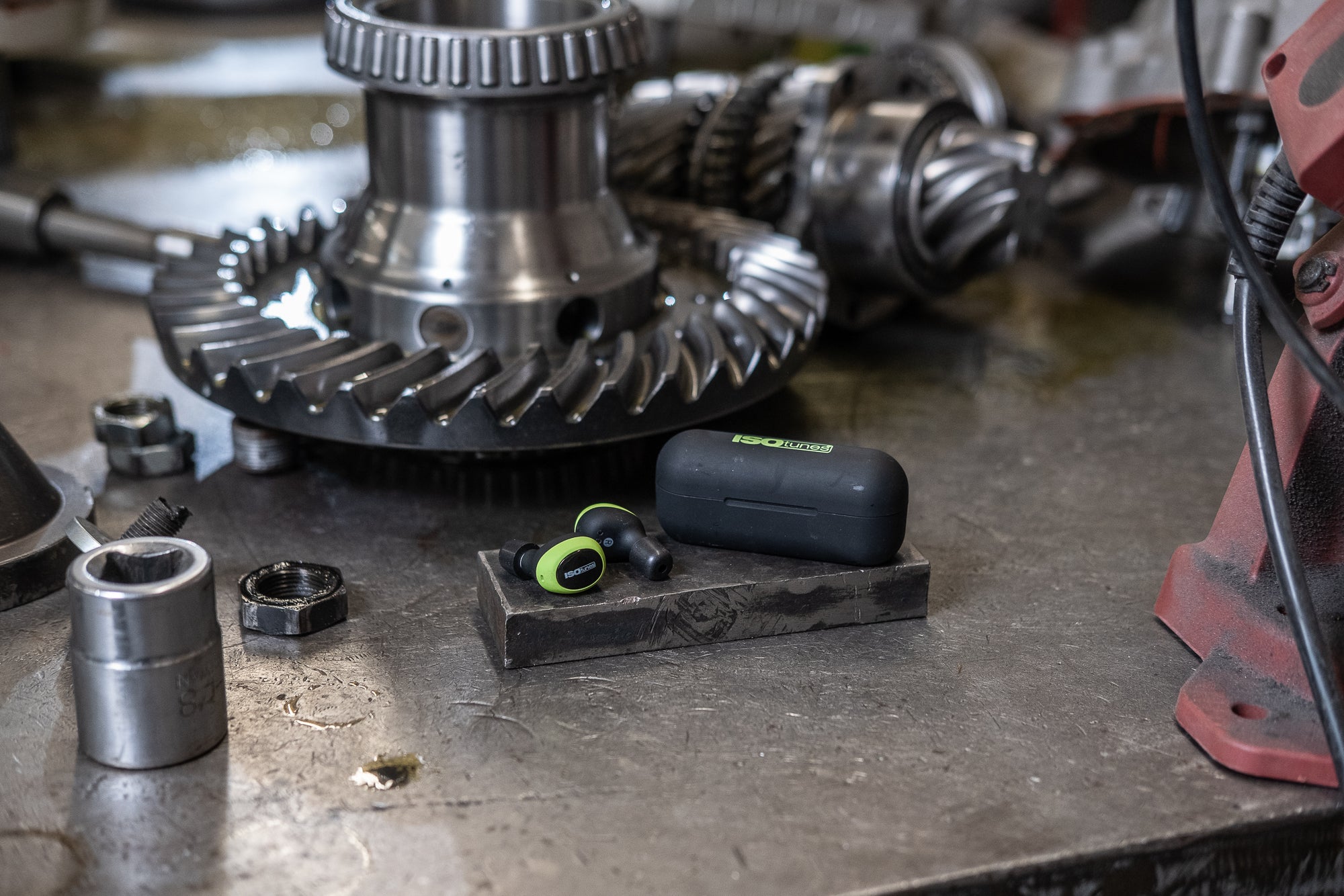According to the National Institute on Deafness and Other Communication Disorders (NIDCD), it's estimated that about 15% of all Americans over the age of 18 report some sort of issue with their hearing. To further quantify this number, that's approximately 37.5 million people.
While age tends to be the leading factor associated with hearing loss, there are plenty of other factors that contribute to such issues. One of them is exposure to chronic noise, something that often happens in industrial environments, on construction job sites, or in the home workshops of hobbyists or DIYers. And while certain steps can be taken to prevent further hearing loss, it's often an irreversible condition. Yes, you can see a medical professional to be fitted for a hearing aid to improve overall hearing, but there is no magic cure for recovering this crucial sense.
In this post, we'll take a closer look at how to know whether or not you're losing your hearing, how you might be damaging your hearing, and what you can do to stop it from getting any worse. Here's a closer look at everything you need to know about hearing loss and what you can do about it:
Common Hearing Loss Symptoms
So how do you know if you're experiencing hearing loss? There are several tell-tale signs to watch out for, but there are also some that aren't so obvious. Here's a look at some of the hearing loss symptoms you should be aware of and monitoring:
People Sound Like They're MumblingIf it seems like you're regularly repeating any of the aforementioned words or phrases and if people generally sound like they're mumbling as they're speaking to you, it could very well be a sign that you've experienced some level of hearing loss.
 If you find it difficult to communicate with coworkers and colleagues, it may be time to check your hearing.
If you find it difficult to communicate with coworkers and colleagues, it may be time to check your hearing.
On a similar note, if you notice that you're having difficulty hearing people around you when there's lots of background noise, like a crowd, then this could be another sign. This can also lead to additional behavior patterns, such as greater intentions to avoid areas with large crowds present.
Regularly Increasing Volume of Headphones/Speakers
Does it seem like you're regularly turning up the volume on the television set? Especially if someone else in your household was watching it before you at a lower level? Or are you always increasing the volume on your headphones or your car stereo speakers because you're having a hard time hearing what's being said? If you notice you're doing this consistently, it could be a sign of hearing loss. It's easy to chalk this up to fluctuations in TV and audio recordings, but that's not always the case.
TinnitusTinnitus, or a ringing in the ears, is unpleasant and distracting. It's also a common sign of hearing loss or an ear injury. And while tinnitus is perhaps best associated with age-related hearing loss, it can also be a sign of early hearing loss that stems from external factors.
5 Ways You're Damaging Your Hearing

You could be damaging your hearing and not even know it. That's one of the most concerning things that is often associated with hearing loss - you may not even realize that it's happening to you until it's too late. A lot of this is because it's easy to compensate for hearing loss, such as turning up the volume of speakers or getting closer to others as they're speaking to you. But it's important to realize how you could be unintentionally causing damage to your hearing. Here's a look at five potential culprits:
Working Around the Home/Yard Without Ear ProtectionYou might be surprised to learn just how many household tools and appliances have elevated decibel levels. According to the NIDCD, any noise at or below 70 decibels (dB) is generally considered safe. However, long or regular exposure to sounds at or above 85 dB can cause hearing loss. Here's a look at some of the average decibel levels of some often-used household tools and appliances:
|
Household Tools / Appliances |
Decibel Level (dB) |
| Vacuum Cleaner | 85 - 89 dB |
| Electric Mixer | 89 - 91 dB |
| Gas-Powered Lawn Mower | 88 - 94 dB |
| Hairdryer | 80 - 95 dB |
| Air Compressor | 90 - 93 dB |
| Electric Drill | 92 - 95 dB |
| Lawn Trimmer | 95 - 96 dB |
| Circular Saw | 100 - 104 dB |
Listening to Music Above 85 Decibels
As mentioned, long or regular exposure to sound at levels at or above 85 dB can cause hearing loss. Most earbud headphones can reach a maximum sound capacity of about 115 dB, which can be very harmful if put on full blast. Even the maximum output of a home or car stereo can be up to 110 dB.
Regular Exposure to Loud NoisesAside from household tools and appliances, there are a variety of other loud noises that you may regularly come into contact with in your professional or day-to-day life. Here's a look at some of them:
|
Event |
Decibel Level (dB) |
| Concerts and Sporting Events | 94 - 100 dB |
| Emergency Vehicle Sirens | up to 129 dB |
| Fireworks | up to 160 dB |
Whether you're a paramedic, an avid concert or sports game attendee, an arena concessions worker or a fireworks hobbyist, there are several contributors that may be contributing to hearing loss in both your personal and professional life.
High Blood Pressure, DiabetesResearchers believe that high blood pressure and diabetes can contribute to hearing loss by damaging nerves and blood vessels. The good news is that taking the proper measures to prevent these conditions can help prevent hearing loss. The bad news is that more than 30 percent of all American adults have high blood pressure - and about 20 percent of them do not know they have it.
A Combination of Any of the AboveCertainly, experiencing more than one of the above is likely to increase your chances of developing hearing problems. And though hearing loss can often not be reversed, it can be treated. Hence, if you experience one or more of the above, we'd suggest you take a hearing loss test to properly assess your hearing and then seek corrective attention if necessary.
How to Prevent or Stop Hearing Loss
As is the case with most medical conditions, it's best to be proactive - and not reactive - when it comes to preventing hearing loss or stopping existing hearing issues from becoming any worse. Here's what you can do:
Regularly Check Your HearingIt's good to get into the habit of regularly giving yourself a hearing loss test - and the nice thing about doing so is that you don't need to go to the doctor to do it. There are plenty of hearing loss tests that you can do at home from your computer, and they can give you an assessment of your hearing in minutes. If your score comes back abnormal, you should make plans to see a doctor. This is especially noteworthy when you consider that hearing loss can stem from potentially undiagnosed underlying conditions, such as high blood pressure or diabetes.
Don't Raise Your Headphone Volume Beyond 85 dB
Whether you're going for a jog, working around the house or just doing work at your desk, it's common to throw on a podcast or some tunes to help you pass the time. But like we've said throughout this piece, if you're listening to anything on your headphones, you don't want the volume to exceed 85 dB or else you could risk hearing loss. That's why every ISOtunes product comes with SafeMax™ Technology, an 85 dB volume limiter that doesn't put your ears at risk. You can check your decibel levels on the "Health" app on your iPhone or related app on your Android device.
You can also manage your volume output on your iPhone, Android, or related device. Check your decibel levels on the "Health" app or limit your volume manually. You can go into your phone's settings to adjust the maximum volume your headphones will play at. Set this on your iPhone by going to Settings, then tapping "Sounds & Haptics." Tap "Headphone Safety" and you should now be able to activate a slider to reduce loud sounds and take action to ensure headphone levels don't reach a certain volume.
Wear Proper Hearing ProtectionNow that you know the volume of some of the common household tools and appliances that you regularly use, as well as other loud sounds that you may encounter either personally or professionally, be sure to take the necessary precautions to protect your ears when necessary. You can do this by picking up earmuffs or earplugs to protect your hearing and prevent hearing loss.
Look into Safer Headphones

Like we said above, it's common to want to work while listening to music - and in order to hear music when you're around other loud noises, headphones are often used to create more of a personal experience and drown out any background noise. Unfortunately, many of these headphones don't properly protect your ears, so you could be doing more harm than good in said situations. That's where ISOtunes comes in. Our Bluetooth headphones are purpose-built to deliver the entertainment you need while also protecting your hearing from everything else around you.



